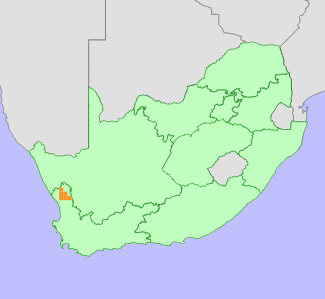|
Scientific Name | Conophytum subfenestratum Schwantes |
Higher Classification | Dicotyledons |
Family | AIZOACEAE |
Synonyms | Conophytum edithiae N.E.Br., Conophytum lucipunctum N.E.Br., Conophytum pillansii Lavis, Ophthalmophyllum subfenestratum (Schwantes) Tischer |
National Status |
Status and Criteria | Critically Endangered A4d |
Assessment Date | 2021/12/09 |
Assessor(s) | A.J. Young, P.G. Desmet, I. Ebrahim, D. Guo, A. Harrower, L. Jabar, L. Knoetze, C. Rodgerson, P.C.V. Van Wyk & N.N. Mhlongo |
Justification | This succulent is endemic to the Western Cape of South Africa with an extent of occurrence (EOO) of 1,407 km2 and area of occupancy (AOO) of 84 km2. The population is in decline due to illegal collection for the international trade in ornamental succulents and more than 10,000 mature individuals (from an estimated population of 50,000-150,000) have been removed since 2019. Illegal collection is likely to increase as there has been a dramatic increase in the number of species and volume of plants targeted since 2019 including many from the immediate area. The continued threat of illegal collection is therefore regarded as very high for this particular species. A decline of up to 95% of the population is very likely within the next thirty years (one generation). Climate change may also contribute to population decline, however poaching is the more immediate threat that will impact this species in the short term. It therefore qualifies as Critically Endangered under criterion A4. |
Distribution |
Endemism | South African endemic |
Provincial distribution | Western Cape |
Range | This species is endemic to the Western Cape of South Africa where it is found within a restricted geographic range. |
Habitat and Ecology |
Major system | Terrestrial |
Major habitats | Succulent Karoo |
Description | This species is endemic to the Succulent Karoo biome where it is primarily found within the Knersvlakte bioregion but smaller numbers of plants are also present in the Namaqualand Hardeveld bioregion. The plants are particularly widespread across quartz flats, typically as scattered individuals or in small colonies consisting of a few individuals. It is occasionally abundant on small quartz outcrops.
It has a generation length of 30 years. It is expected to be sensitive to the impacts of climate change as it does not disperse and while adapted to arid conditions, is dependent on limited seasonal rainfall. Species in the genus are sensitive to long periods of drought. Drought related mortality has been observed for other closely related taxa within the genus. |
Threats |
| This species is currently threatened by illegal collection for the international trade in ornamental succulents. This is likely to increase in future as there has been a dramatic increase in the number of species and volume of plants targeted since 2019. More than 10,000 mature individuals have been illegal removed from habitat since 2019 from an area well known and targeted for its succulent richness. As a result a population decline of up to 95% is suspected over a single generation (30 years).
Anthropogenic climate change is a long-term threat to this species. There is no decline in habitat quality for this taxon as inferred by changes in vegetation cover determined from changes in Enhanced Vegetation Index (EVI) between 1984 and 2018 using Landsat data (Venter et al. 2020). Climate models for the likely emission scenarios where emissions stay at present day levels (RCP 2.6) (Hausfather and Peters 2020) and worst case scenarios where emissions continue to increase during the 21st century (RCP 8.5) indicate that there will be a loss of suitable bioclimatic envelope of between 61% and 92% by 2080 for this species. However, as this species possesses certain morphological traits likely to afford resilience to xerophytic conditions and is found across several vegetation units it is expected to have a level of resilience to climate change and the expected population loss is reduced by 20% to 41%. Species in this genus have limited dispersal ability and migration to suitable habitats elsewhere is regarded as highly unlikely. |
Population |
This succulent is typically found as scattered individuals or as small colonies of just a few plants. There are no formal estimates of population size for this species but there are likely between 50,000 and 150,000 mature individuals. The population is in severe decline due to illegal collection for the ornamental succulent plant trade. At least 10,000 plants have been removed from habitat between 2019 and the end of 2021 based on confiscation records, with many more having likely been removed but not intercepted by law enforcers.
|
Population trend | Decreasing |
Assessment History |
Taxon assessed |
Status and Criteria |
Citation/Red List version | | Conophytum subfenestratum Schwantes | Least Concern | Raimondo et al. (2009) | |
Bibliography |
Hammer, S. 1986. Ophthalmophyllum subfenestratum: a Conophytum conundrum. Aloe 23(2):39-42.
Hammer, S. 1997. Unusual forms of Conophytum subfenestratum Schwantes. Aloe 34(1-2):14-16.
Hammer, S. 2002. Dumpling and his wife: New view of the genus Conophytum. EAE Creative Colour, Norwich.
Hammer, S.A. 1993. The genus Conophytum: A conograph. Succulent Plant Publications, Pretoria.
Hausfather, Z. and Peters, G.P. 2020. Emissions - the 'business as usual' story is misleading. Nature 577(618-620).
Opel, M.R. 2004. The rediscovery of Crassula alcicornis. Haseltonia 10:38-40.
Raimondo, D., von Staden, L., Foden, W., Victor, J.E., Helme, N.A., Turner, R.C., Kamundi, D.A. and Manyama, P.A. 2009. Red List of South African Plants. Strelitzia 25. South African National Biodiversity Institute, Pretoria.
Snijman, D.A. 2013. Plants of the Greater Cape Floristic Region 2: The extra Cape flora. Strelitzia 30. South African National Biodiversity Institute, Pretoria.
|
Citation |
| Young, A.J., Desmet, P.G., Ebrahim, I., Guo, D., Harrower, A., Jabar, L., Knoetze, L., Rodgerson, C., Van Wyk, P.C.V. & Mhlongo, N.N. 2021. Conophytum subfenestratum Schwantes. National Assessment: Red List of South African Plants version 2024.1. Accessed on 2025/11/07 |
 Comment on this assessment
Comment on this assessment


